Menus
- Size question
- 4 cylinders in line, 636 cm3, 130 hp, 70.8 Nm, 196 kg full made, 11,699 euros
- Discovery
- In the saddle
- Highway
- Departmental
- City
- Part-cycle
- Braking
- Comfort
- Consumption
- Video test
- Conclusion
- Test conditions
- Test equipment
Size question
4 cylinders in line, 636 cm3, 130 hp, 70.8 Nm, 196 kg full made, 11,699 euros
While everyone agrees to put the 600 Supersport category in the motorcycle history books, since only 1000 and less than 500 cm3 find favor in the eyes of manufacturers (the time is wide apart, sometimes to extremes….), Kawasaki has just taken the ZX -6R out of its green hat. While it’s not really a brand new model – it uses the same 636cc engine and chassis as the model retired in 2017 – it gets some nifty tweaks, not to mention the performance version with its accessory pack. So much so that this essay woke up the old question, at the center of everything: does size matter ?
 2,085 x 705 x 1,115 mm for a wheelbase of 1,395 mm
2,085 x 705 x 1,115 mm for a wheelbase of 1,395 mm
Discovery
Before answering this crucial question, let’s rediscover the wasp. Because it’s almost on the sly that the ZX-6R comes back to us. Usually, brands organize press presentations to give their novelty a "com boost", but this time nothing in France. Even if this isn’t a brand new bike, this kind of event makes you say, "Hey, the ZX-6R is coming back!" »And the dealers appreciate, even if the customers of this type of sports car are becoming scarce each year (around three hundred 600 cm3 sports cars were sold in France in 2018). In the United States, a market obviously larger than ours, such a presentation took place last October in Las Vegas, bringing together journalists and dealers. No one was moved when the engineers detailed the few evolutions of the 2019 ZX-6R, however, clamors flew when the head of communications spoke about the price. We could have done the same in France: the ZX-6R now costs 11,699 euros, almost 2,000 euros less than in 2016. It is therefore worth 1,000 euros less than the Z 1000 and Z 900 RS, so that its technology (frame, electronics, etc.) is more advanced. Above all, it is 2,300 euros cheaper than its big rival (note that there is not much left …), the Yamaha R6. Kind of price stab. If every contemporary sportswoman is a technical diamond, then it is the accounting department that has taken the spotlight.
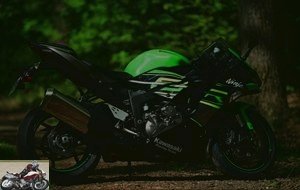 194 kg all full made with ABS but without accessories
194 kg all full made with ABS but without accessories
What does she offer for this price? The most obvious remains the new skin, halfway between Ninja 400 for the front part and ZX-10 R for the rear, a sort of half-section of each, harmonious all the same, the work of Miki Nagase, the Kawasaki designer for five years. The dashboard is new too, stuffed with little digital bars, but luckily the tachometer remains clear and traditional..
 Digital and traditional display
Digital and traditional display
All lighting is now LED.
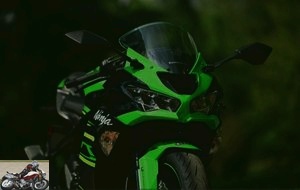 Rather green or black ?
Rather green or black ?
Subtlety specific to the Kawa, the lock under the rear side does not unlock the passenger seat, but the pilot seat, under which we find a small cable on which we pull to remove the second seat…. Old. But at 11,699 euros, we are not going to whine for this kind of nonsense.
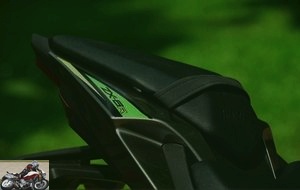 Passenger seat
Passenger seat
New in 2019, the shifter, only for upshifting (and not the "up and down" reserved for the 1000 goddesses), traction control adjustable in three levels and still two engine modes, called F for Full and L for Low. This last mode does not change the power but the way it is delivered, with progressivity. Which power remains roughly the same as before, despite the new Euro4 standards. If the bore and the stroke of the pistons, the compression ratio or the number of valves (sixteen) have not changed compared to the 2016 version, the injection if: the gas mixture is now distilled by bodies of 38 mm, with double injectors. The exhaust has been modified accordingly. The attention of the engine manufacturers has been focused on the torque, which is not the strong point of this style of mechanics and we will see that they have worked rather well. Another small change, apparently innocuous, the gearbox output pinion has lost one tooth (this corresponds to approximately three more teeth on the crown), which changes a lot of things, as we will also see.
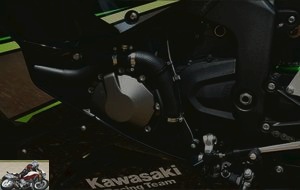 636 cc liquid-cooled 4-stroke in-line four cylinders
636 cc liquid-cooled 4-stroke in-line four cylinders
The big Showa Big Piston fork did not budge, hydraulically adjustable and spring loaded, as did the shock absorber. The triangulation of the riding position hasn’t changed either, but the new fuel tank feels like it has a better grip on the bike. Detail, the clutch lever can also be adjusted, again a matter of size, this time by hand.
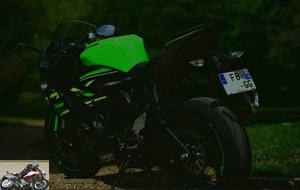 Rear tire 180 / 55ZR17M / C (73W) / 120 / 70ZR17M / C (58W) at the front
Rear tire 180 / 55ZR17M / C (73W) / 120 / 70ZR17M / C (58W) at the front
In the saddle
I dreaded this moment a little, knowing that I was going to spend a fortnight of my daily life with the ZX-6R. I look at her, buttocks up, bracelets low, I take a last wet look for my placid CBF 600 and her right handlebars, I go for it. Raising my right leg, passing over the rear saddle, the left foot pointed on the ground (saddle at 830 mm high requires), I had forgotten this dance, only a week after leaving a small Yamaha R3. I settle down, as if I were stepping into a box, my knees pressed to the tank, my arms half bent.
The tachometer immediately impresses me, more welcoming this one: the red zone starts at 16,000 rpm! Any ’80s 500 two-stroke would have dreamed of it. The soft clutch allays my fears, the shifter amazes me. Shift gears easily, without touching the clutch, even at 3000 rpm with the throttle barely open. First bumps and speed bumps (the contemporary wound), new smile, the suspensions seem to be of a high quality, damping progressively, even at low speed. This is for me one of the essential criteria with these madnesses of the road, the quality of the suspensions. Never two without three (I don’t know how much good news I got anymore), another nice surprise, the smooth engine, not hollow, almost round, more in any case than that of my Honda road. However, I was hoping for better handling around town or on the way. True to sporting precepts, the ZX-6R can be handled as a whole, it does not spin, it engages, whole. The 180 rear tire, standard for any mid-size bike today, is still too wide in my opinion.
I know from experience (age ….) that discovering a motorcycle takes place in several stages. I cut this first meeting short, stop after about thirty terminals, make a phone call etc. I take the handlebars, second flavor, I start to get used to the position. When it rolls, it supports itself, at less than 60 km / h, it drives crazy. Further away, where people are scarce, the ZX-6R expresses itself, without having to come up with cold sweats or hot spots.
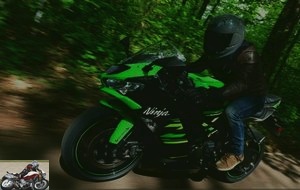 71 Nm {7.2 kgfm} at 11,500 rpm
71 Nm {7.2 kgfm} at 11,500 rpm
Highway
The A13 promises the green deserts of Normandy. It is not very crowded today, I am starting to land at 130 km / h, the tachometer is at 8,000 rpm! The gearbox output pinion with its tooth less explains it, that’s not going to do the business of consumption, that. The bubble doesn’t protect much, luckily I’m only 1m67; the giants, forget the ZX-6R and even any sportswoman in general, or treat yourself to a Tourist Trophy or endurance type bubble, curved and raised, it looks classy and it shelters. First service station, I quickly calculate the consumption, we exceeded 7 liters per 100 km, dragging ourselves to the limits ….
Further on, numbness threatens, I alternate between supports on the arms to relieve the legs and vice versa. On a sports car, we do sports, cladding, even at 140 in a straight line. I amused myself by testing the flexibility of the engine on the sixth report, quite bluffing. The 636 has always been distinguished by its roundness (thanks to the stroke of its pistons not too short), its extra muscle at mid-range, a real trick of daily pleasure, because we are not always in good spirits. to push relationships to the limit every day that God (or some other) does. Okay, basta, I’m going out of the corridor, direction Pont-Audemer.
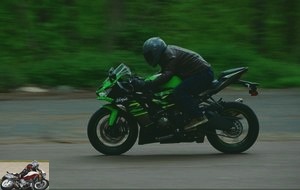 78.2 kW {106 hp} at 13,500 rpm, 101 kW {137 hp} at 13,500 rpm with RAM Air
78.2 kW {106 hp} at 13,500 rpm, 101 kW {137 hp} at 13,500 rpm with RAM Air
Departmental
There you are, that’s the road. A little gray tongue in motion, fields on the edges, clear visibility, both for tractors and radars. I have great confidence in the Bridgestone S22, originally fitted to the ZX-6R. They don’t betray my feeling. The chassis is prodigious, the front axle reassures, sends the info Twitter style, it remains stable, no strange movements or feeling of heaviness (we also speak of the front axle which "engages", although it does not engage. not to tempt the devil), worthy of a road sportswoman. It is possible that on the track the ZX-6R may lack a bit of liveliness, we will check one day, but for the road, for us what, it is perfect. The association between quality tires and very high level suspensions never deceives.
And I’m thinking at this moment of a big 1000, ZX-10R or GSX-R and I can’t say what else they have other than costing double the ZX-6R. We come to the size. Frankly, on a Normandy or Corsican, Auvergne or Cevennes departmental, who believes that a 1000 will give more pleasure, less trouble than a 600 like this Kawa? Right now, I won’t trade the 636 for any big thing, be it Panigale V4 or MV Agusta F4. And the sharp sound of the “small” four-cylinder, which borders on 14,000 rpm, with large shifts in the shifter, helps to rebuild all the usual dimensions. There, it goes fast, it screams, it makes you want to yell with joy, it’s another dimension, above the others, a little bit above it, but we fly over it anyway, like a low-level hunting.
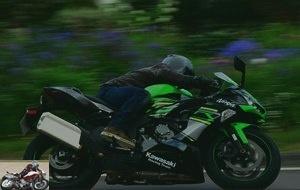 Lightness and maneuverability on the road
Lightness and maneuverability on the road
There is no question of efficiency, a 1000 will always go faster than a 600 (see the lap times of small circuits like Croix-en-Ternois or Carole) but a jumble of sensations, between lightness and power , screeches and adrenaline, the 600 are awesome! It reminds me of my ZXR 400, 25 years ago, intractable in the S of Pourville (only Dieppois will understand), ridiculing stupidly heavy FZR 1000 or GSX-R 1100. Question of size? Lightness is THE luxury on a motorcycle, those nostalgic for two-stroke will tell you about it. The figures speak little: 196 kg all full facts announced for the ZX-6R, only 10 kg more for the ZX-10R (more or less 10%, would have to be weighed …), it has nothing more to do with the 50 kg which separated my 400 ZXR from a GSX-R 1100. But the inertia of a 1000 cm3 impresses, embarks on the outside, leaves less room for improvisation, even when you are not attacking. I am amazed to rediscover the 600 class. We have to be fair, however, the Yamaha R6, if it is more expensive, is also more agile, even more alert. But I think I would prefer the Kawa for everyday driving, again thanks to its rounder engine..
City
Back in urban hell, I’ve talked about it before, it’s not the critter’s ideal playground. A few practical details, however: the stand unfolds easily thanks to its lug, it is neither too high nor too low (depending on the height differences), the controls are located quickly, like the most useful information on the dashboard (speed, fuel gauge, trip, clock). The mirrors are sufficiently readable. When the weather is hot, the engine does not release its calories to the pilot. Under the saddles (….), Nothing will be stored other than a yellow vest (I’m talking about clothing….). And consumption is not going down, on the contrary, it is flirting with 8 liters per 100 km. It is less a question of size than of space, the sport is practiced in wide horizons. But a 1000 is even more painful than a 600 in town. We will believe that I am an activist ….
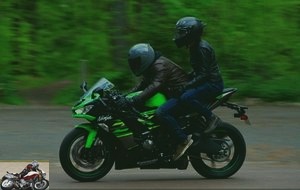 Duo on short trips
Duo on short trips
Part-cycle
Stability and confidence in the train remain the immense strengths of the ZX-6R. It handles easily, it remains 600, but less than an R6 or Triumph 675 Daytona, when it still existed. On the road, the Kawa drives round trajectories, engine stalled in the hurlevents, shifter on the shoe, or more quietly, but still in curves. This agreement between reassuring and efficient chassis and full engine (for a 600 cm3) perfects the personality of the Kawa. She is positioned as an obvious road sportswoman, capable of circuit, capable of bloodstains, capable of 365 days with the banana. The rest is a matter of aesthetic tastes and that is up to you. Have the curiosity to rediscover a 600 sport.
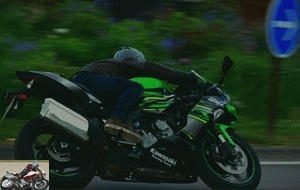 Follow the arrow
Follow the arrow
Braking
The other big highlight of the ZX-6R is its powerful and progressive braking. In front, there are two radial monobloc Nissin calipers with 4 pistons, which pinch two discs of 310 mm in diameter. It causes. The rear is mainly used to tighten a course, or slow down. The harmony between this braking and the fork, which is able to withstand the stresses of braking, contributes to the harmony of the Kawa. ABS cannot be disconnected.
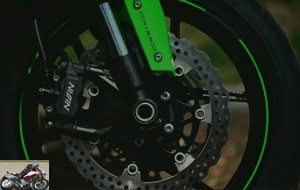 Double discs in semi-floating 310 mm (x t5 mm) petals. Two radial monobloc calipers with 4 opposing pistons, Nissin
Double discs in semi-floating 310 mm (x t5 mm) petals. Two radial monobloc calipers with 4 opposing pistons, Nissin
Comfort
Always ironic parameter when we talk about sports. The wide saddle lacks padding, fortunately the suspensions cushion very well. The driving position is typical of the genre, with straps a little too tight for my taste. You shouldn’t hesitate to adapt them to your morphology. Too bad also that the footrests are not adjustable. Sportswomen, more than any other motorcycle, deserve to adapt better to different builds. Regarding the duo, no need to spend too long, it is painful, without grab handles, but some passengers love the toad position, the ZX-6R will delight them.
 Very high position for the passenger
Very high position for the passenger
Consumption
I have already spoken about it above, the ZX-6R is quite greedy, its engine often grinds at more than 8000 rpm (half of the tachometer), which explains the some 7.3 l per 100 km average of this essay. It is always possible to lengthen the final reduction, but that would be detrimental to the joy of the four-cylinder. Result, we will do an average of two hundred kilometers before the reserve ignites with the 17-liter tank..
Video test
Conclusion
It’s a real pleasure to find the ZX-6R again and almost a militant act to go at least try it (like all 600 sports cars), to protect the species. We lost the two-stroke, we lost the 400 four-cylinder, the mid-capacity road cars, let’s make sure we don’t lose the 600 sports cars. The ZX-6R combines an engine capable of furious revs and pleasant mid-revs, a reassuring chassis perfect for the road, all at a really attractive price. A nice motorcycle, which we might like available in less garish colors, or more sober ….
Strong points
- Front axle stability
- Quality of suspensions
- The 16,000 rpm before the red zone !
- Braking
- Engine flexibility
Weak points
- Weak bubble protection
- High consumption
- Handling less than the R6
Kawasaki ZX-6R technical sheet
Test conditions
- Route: 560 km between the Paris region and Normandy, but above all in daily use
- Weather: alternating good weather and rain, between 7 and 20 °
- Motorcycle mileage: 1.552 km on the odometer at the start
Test equipment
- Spidi Garage Jacket
- Araï Profile-V Helmet
- Gloves VQuattro V4
- Vanucci Tifoso VTS4 Shoes
Related articles
-
Kawasaki Versys 1000 S Grand tourer motorcycle test
Daily test for fifteen days 1,043 cm3, 120 hp at 9,000 rpm, 102 Nm at 7,500 rpm, 257 kg, 15,099 euros (17,099 euros Grand Tourer version) This bike, to…
-
Kawasaki Ninja ZX-10R KRT motorcycle test
An integer character 4 cylinders in line, 998 cm3, 203 hp, 114.9 Nm, 206 kg all full facts, 18,099 euros. Nice surprise for me to find the Kawasaki…
-
Evolution Like few models, the Z can boast of having built a first name within its own brand. After eight years of hegemony in the flagship motorcycle…
-
40 horses at 11,500 rpm 25.7 Nm, 175 kilos with full tank, two colors, € 5,799 An easy and sparkling little trail: what if life on a motorcycle was as…
-
Kawasaki ZX10R motorcycle test
The motorcycle division of the giant Kawasaki industry, is only a drop in the sea, but that does not prevent it from being a major player in the world of…
-
4 cylinders in line, compressor, 998 cm3, 210 hp at 11,000 rpm, 137.3 Nm at 9,500 rpm, 260 kilos, € 21,999 Kawasaki reinvents the super-fast and…
-
Kawasaki Z H2 Supercharged motorcycle test
200 hp, 14 mkg at 8,500 rpm, 239 kg all full, 17,099 € Put some salt ! Fifteen days of driving with the Kawasaki Z H2? I say it bluntly, it takes less to…
-
Kawasaki Versys 1000 motorcycle test
La Z goes green Eternal absent from the Kawasaki range, apart from the unlikely KLV 1000 (Suzuki V-Str m renamed), the maxi-trail model finally appears…
-
4 cylinders in line, 948 cm3, 111 hp at 8,500 rpm, 10 m / kg at 6,500 rpm, 215 kilos, from € 11,999 A skillfully modified Z 900 or the worthy heir to the…
-
Kawasaki Ninja ZX-10R motorcycle test
The good vein 4 cylinders in line, 998 cm3, 203 hp and 11.7 mkg at 11,400 rpm, 206 kg all full, 19,399 euros. Who has not had their adored sportswoman,…
But she has what in hand the passenger?
Ah OK
a pole for the video…
P …. I believed in a baton to calm the pilot…
Philippe> the noise standard is measured dynamically (acceleration from 50 to 80 km / h on a defined gear ratio, the measured noise should not exceed 85dB I believe).
It is possible that these details have evolved in recent years, but the principle remains.
Noise at a standstill is therefore not taken into account at all.
The value used for the static check (that shown on the vehicle registration document) is then measured for each model, taking the value 3/4 (for the 4 cylinders) or 2/3 (mono and bi) of the maximum speed.
Yes I know Euro3 = 85 / 90db, Euro4 = 80db
But it is the problem of the tricks that manufacturers find to pass these standards (like an exhaust valve), and on this subject the German government has just voted (on May 15) to tighten the sanctions for noisy two-wheelers, which apart from the seizure of vehicles and copious fines for both the owner and the manufacturer, will empower the regions to prohibit the circulation of two wheels on Sundays and public holidays, (as in the Vosges on the German side for a few years)
So the noise assessment will no longer necessarily go through the manufacturer’s approval plate, but through the feeling in terms of nuisance on the part of residents, a whole program.
[attachment 33652 ducatipanigaleV.png]